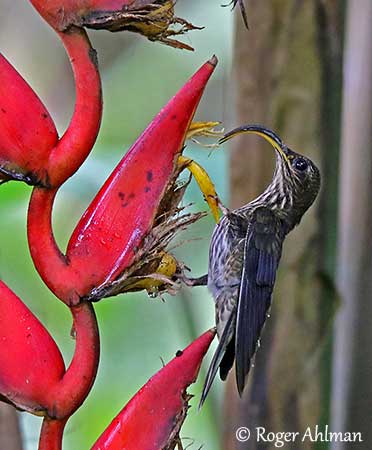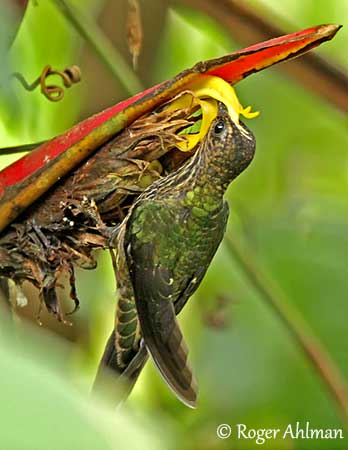
Fr: Bec-en-faucille aigle
Ang: White-tipped Sicklebill
All: Weißkehl-Sichelschnabel
Esp: Picohoz Coliverde
Ita: Falcetto codabianca
Nd: Haaksnavelkolibrie
Sd: vitstjärtad liekolibri
Photographer:
Roger Ahlman
Pbase Galleries Peru and Ecuador & My bird pictures on IBC
Text by Nicole Bouglouan
Sources:
HANDBOOK OF THE BIRDS OF THE WORLD Vol 5 by Josep del Hoyo-Andrew Elliott-Jordi Sargatal - Lynx Edicions - ISBN: 8487334253
A GUIDE TO THE BIRDS OF COLOMBIA by Steven L. Hilty and William L. Brown - Princeton University Press – ISBN 069108372X
BIRDS OF VENEZUELA by Steven L. Hilty – Ed. Christopher Helm – ISBN: 0713664185
BIRDS OF PERU by Thomas S. Schulenberg, Douglas F. Stotz, Daniel F. Lane, John P. O’Neill, Theodore A. Parker III – Princeton University Press 2007– ISBN: 978-0-691-13023-1
Birds of Ecuador De Robin Restall, Juan Freile - Bloomsbury Publishing, 2019 – ISBN: 147297249X, 9781472972491 - 576 pages
Avibase (Denis Lepage)
Birdlife International
Neotropical Birds – Cornell Lab of Ornithology
White-tipped sicklebill
Eutoxeres aquila
Apodiformes Order – Trochilidae Family
INTRODUCTION:
The White-tipped Sicklebill is unmistakable with its very distinctive sickle-shaped bill giving the bird its name. This shape is well-adapted to the feeding behaviour of this bird which feeds on nectar of Heliconia and Centropogon plant species because their tubular shapes are similar to the bend of the bill. It also consumes insects.
The White-tipped Sicklebill is polygynous and sings in small leks and performs aerial displays to attract females. This species nests in a small cup-shaped structure built by the female among Heliconia leaves. The male does not take part in nesting duties.
Three subspecies share the range from Costa Rica to N Peru. The White-tipped Sicklebill is not globally threatened and is described as uncommon throughout the range.

DESCRIPTION OF THE BIRD:
Biometrics:
Length: 11,5-14 cm
Weight: M: 8,5-12,5 g – F: 8-10 g
The White-tipped Sicklebill is relatively large. It has dark shining green upperparts but on the upperwing, the flight-feathers are blackish-brown. The rounded, bronzy-green tail is broadly tipped white.
The underparts are heavily streaked blackish and white. The undertail-coverts have orange-ochraceous edges. The undertail feathers are dark green and brown with white tips.
On the head, crown and nape are dark green.
The strongly decurved bill that bends almost into a 90° arc has dark upper mandible and yellow lower one. The eyes are dark brown. Short legs and feet are pale pink to greyish.
Male and female are similar, but the female has shorter wings than male.
The juvenile has pale tips to secondary flight-feathers, and the rectrices are narrower.
SUBSPECIES AND RANGE:
The White-tipped Sicklebill has three subspecies that differ slightly.
E.a. salvini is found in Costa Rica to W Colombia. This one shows paler edges to undertail-coverts than other races.
E.a. heterurus occurs in W Andes from SW Colombia (Cauca) to SW Ecuador.
E.a. aquila (described above) is found in E Andes from Colombia to N Peru. This race was recently observed in W Venezuela (Mérida).
The nominate race shows more conspicuous white tail tips, and the undertail-coverts have brighter ochraceous edges.
HABITAT:
The White-tipped Sicklebill is common in the understory of wet forest and older second growth woodland. It is usually found in or near Heliconia patches where it feeds on nectar and insects. It also forages at forest edge and near rivers. It occurs from sea-level to 2,100 metres of elevation in Costa Rica and Colombia.
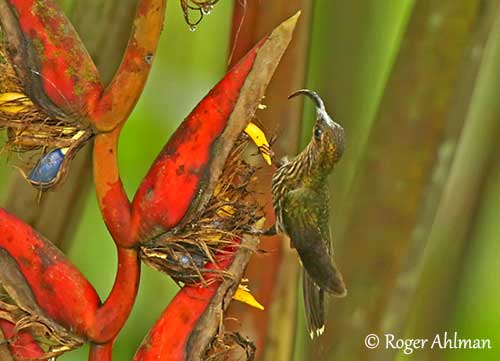
CALLS AND SONGS: SOUNDS BY XENO-CANTO
The White-tipped Sicklebill gives piercing flight calls, high, thin, sharp “tsit”. The song is a complex squeaky chatter “tsi-see’ee’ee’eek-tsi-eek-tsi’ee’ee…” and there are some geographic variations in this song, with a simpler “tsi-se-rik” in W Ecuador.
BEHAVIOUR IN THE WILD:
The White-tipped Sicklebill usually occurs in dense thickets where it feeds alone in the undergrowth. It feeds primarily on nectar from curved flowers and corollas such as Heliconia and Centropogon granulosus. It clings to the flowering plants and probes the curved corollas thanks to the well-adapted sickle-shaped bill. However, it also gleans insects from trunks and branches, and from spider webs.
It usually forages low in the understory. When it is perched, bill and head are usually held slightly up.
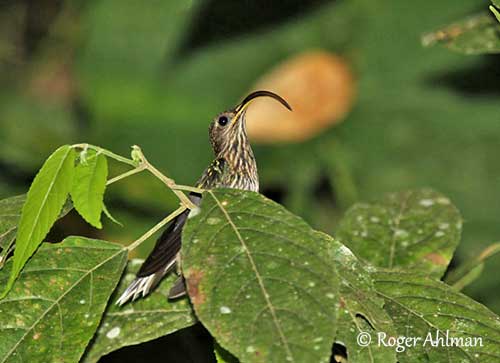
This species is a trap-line feeder, and flies rapidly a long distance to visit scattered flowering plant species, but it does not defend a specific, good foraging area.
The White-tipped Sicklebill is polygynous like most species of Trochilidae. The males sing in small leks, often in Heliconia thickets. During the displays, the males perform a U-shaped flight to attract the females. The male does not take part in nesting duties.
The White-tipped Sicklebill is sedentary, with probably some seasonal movements depending on the range.
It flies with slow, audible wingbeats with some brief pauses.
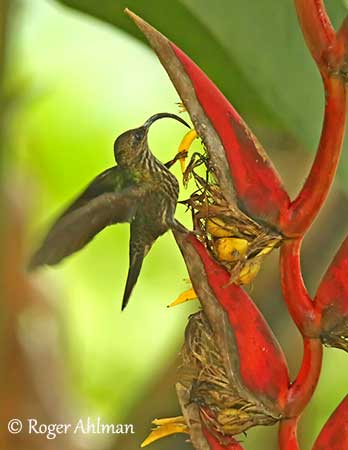
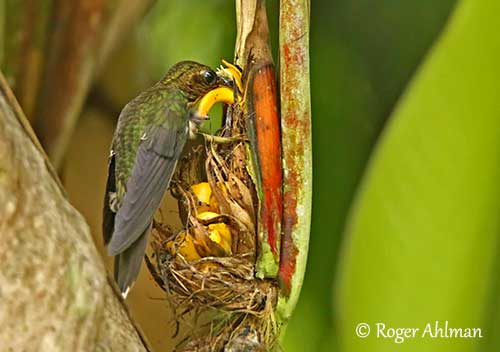
REPRODUCTION OF THIS SPECIES:
The breeding season varies according to the range. It occurs from January to May in Costa Rica, from March to June in Panama, in January and September in Ecuador, and April-June and November-December in Colombia.
The female builds the nest, a cup-shaped structure made with loosely woven palm fibres, often with hanging vegetal tail below. All materials are stick together with spider webs.
The nest usually hangs between 1 and 4 metres above streams or waterfalls. This structure may be placed against a strip of Heliconia leaves or in the underside of larger hanging leaves.
The female lays two white eggs and incubates alone during about two weeks. She feeds the chicks covered with grey down
by regurgitation of partially-digested insects and nectar. The nesting period lasts 22-25 days.
PROTECTION / THREATS / STATUS:
The White-tipped Sicklebill is hard to see in the understory of the humid forest. It is relatively common throughout the range, but mostly local and rare in the upper Magdalena Valley.
The size of the population is unknown, but the species is described as “uncommon”. It is not globally threatened and currently evaluated as Least Concern.
